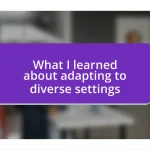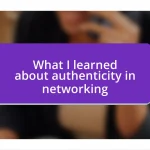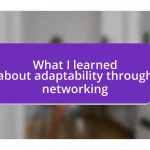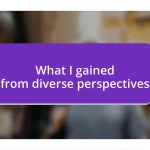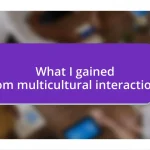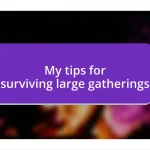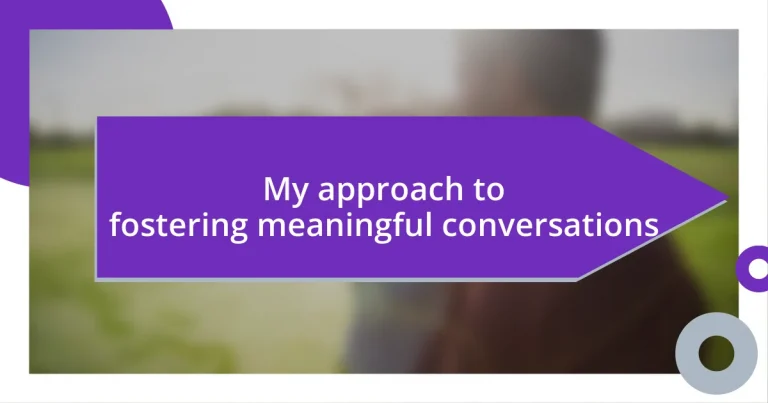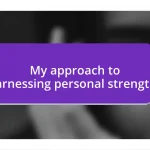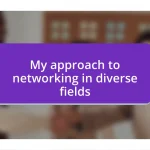Key takeaways:
- Meaningful conversations require active listening, empathy, and creating a safe environment for open dialogue.
- Using open-ended questions fosters deeper connections and encourages vulnerability, allowing for richer exchanges.
- Following up after conversations enhances relationships, showing care and opening avenues for ongoing discussions and support.
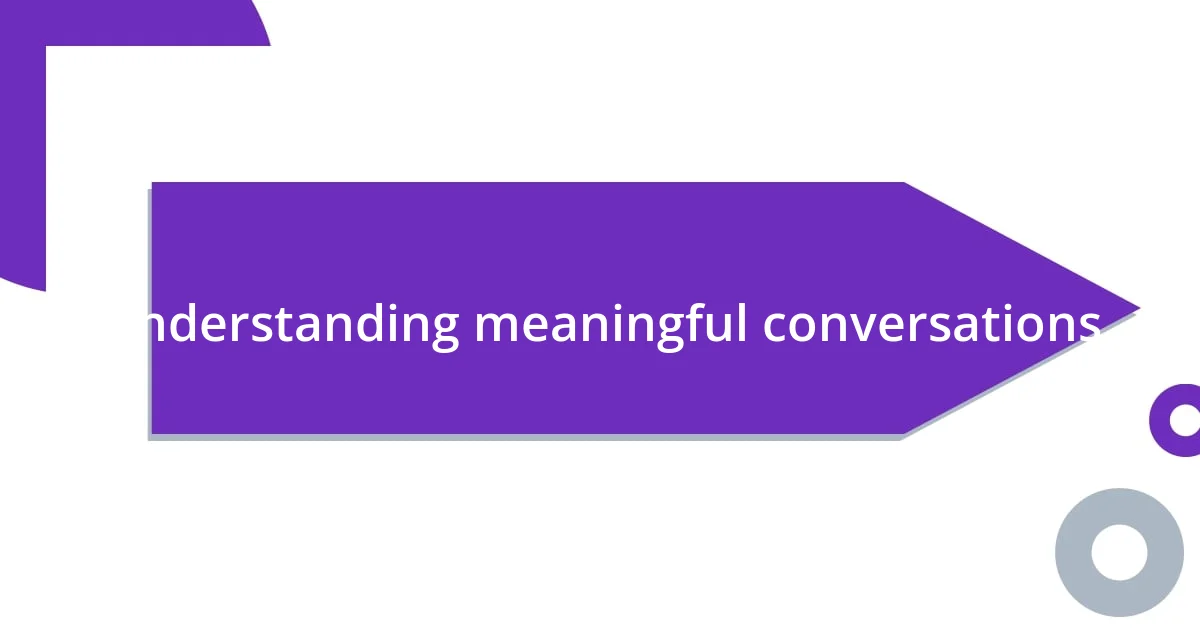
Understanding meaningful conversations
Meaningful conversations go beyond simple exchanges; they require genuine engagement and empathy. I remember a late-night chat with a friend where we stripped away small talk and delved into our fears and dreams. It was profound—there was a raw honesty that bonded us, transforming our relationship.
When I think about what truly makes a conversation meaningful, I often wonder: Are we truly listening, or just waiting for our turn to speak? This reflection hit home during a discussion with a colleague who felt unheard. By actively listening and validating her feelings, I felt our connection deepen, showing me the power of being present in the moment.
Moreover, I’ve found that meaningful conversations often evoke vulnerability. Sharing a personal challenge with someone can feel daunting, yet it’s in those moments of openness that trust flourishes. Have you ever felt that rush of relief when someone responds with understanding rather than judgment? That’s the beauty of a genuine exchange—it creates a safe space for both parties to feel and heal.
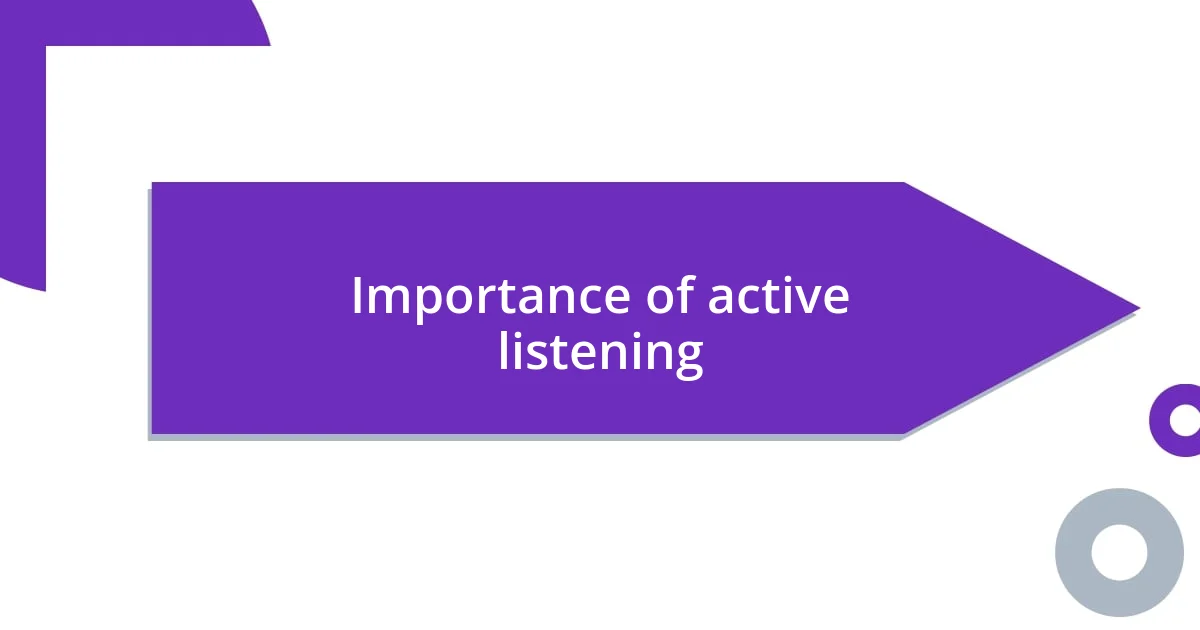
Importance of active listening
Active listening is crucial for fostering meaningful conversations. It means fully concentrating, understanding, responding, and then remembering what the other person is saying. I remember a time during a family gathering when my cousin shared her struggles with a recent job loss. Instead of thinking about my own experiences, I focused entirely on her words. The relief she felt was palpable; she expressed how rare it was for someone to listen without interrupting. This moment reinforced my belief that when we listen actively, we validate the speaker’s feelings and create an environment ripe for honest dialogue.
Here are a few reasons why active listening holds such significance:
- Builds Trust: When people feel heard, their trust in you deepens, creating a safety net for open sharing.
- Enhances Understanding: Active listening allows me to grasp nuances that might be missed in a casual chat, fostering deeper connections.
- Encourages Vulnerability: I’ve noticed that when I genuinely listen, others feel more comfortable sharing their true feelings, leading to more profound exchanges.
- Reduces Misunderstandings: I’ve often found that taking the time to listen prevents miscommunication, which can lead to conflicts.
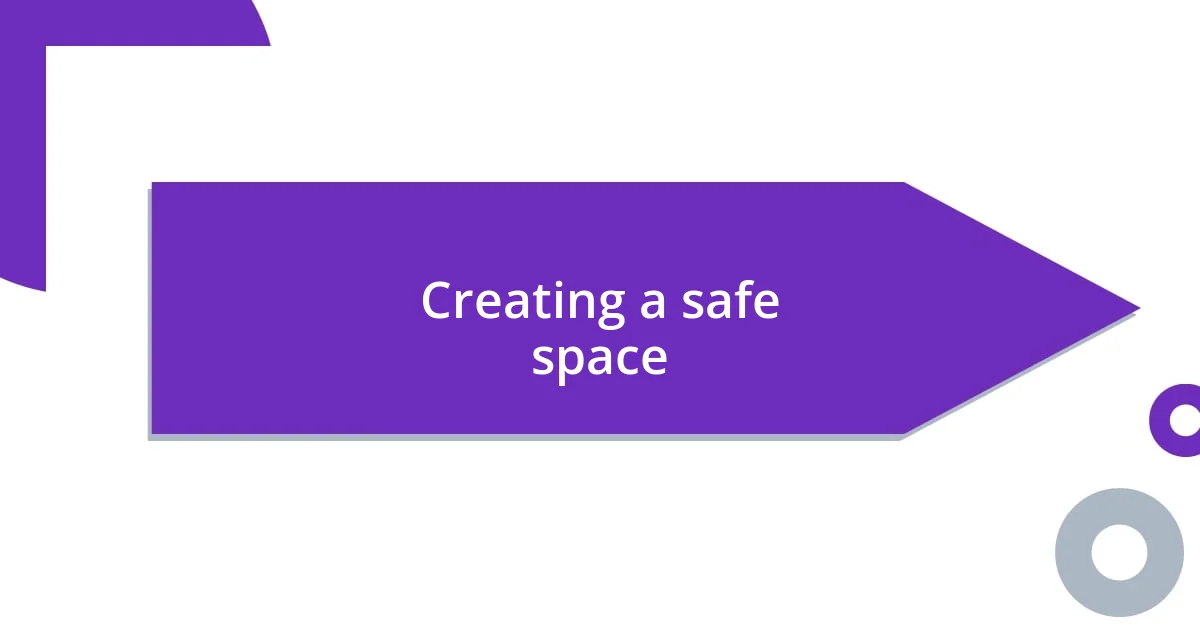
Creating a safe space
Creating a safe space for conversation is essential for meaningful exchanges. When I reflect on my interactions, I realize that non-verbal cues play a significant role in this. For instance, sitting across from someone with an open posture can make them feel more at ease. One time, while discussing a sensitive topic with a close friend, I made sure I maintained eye contact and nodded in understanding, which encouraged her to share even deeper layers of her experience. It’s amazing how these small gestures can communicate support and validation.
Another critical aspect is establishing trust through confidentiality. I often tell people upfront that what we discuss is between us. This notion of privacy has opened the door for more honest dialogues. I recall a time when a colleague confided in me about their struggles with burnout. Knowing that I wouldn’t share their story with others allowed them to express their feelings without fear of judgment. This moment highlighted how safety can empower individuals to be vulnerable.
Lastly, creating an atmosphere where it’s okay to pause and reflect allows for richer conversations. I try to incorporate moments of silence into discussions. I once had a long chat with a mentor where we sat in silence, just contemplating our thoughts. That stillness was powerful; it gave us both the space to process our feelings and deeper questions about our journeys. I believe that while words are important, sometimes the pauses speak just as loudly.
| Aspect | Example |
|---|---|
| Non-verbal cues | Maintaining eye contact and open posture |
| Confidentiality | Assuring that conversations are private |
| Moments of silence | Incorporating pauses to reflect |

Using open-ended questions
Using open-ended questions transforms the dynamics of a conversation. I often find that instead of asking yes-or-no questions—like “Did you enjoy the event?”—I’ll ask, “What was the most memorable part of the event for you?” This subtle shift invites a deeper response. I can still remember the time I used this approach with a friend who had just returned from a trip. Instead of a simple answer, she opened up about her experiences in ways that surprised both of us.
Open-ended questions help uncover thoughts and feelings that might remain hidden otherwise. I’ve noticed that when I ask questions like, “How did that incident make you feel?” it creates a space for vulnerability. During a chat with a family member who was grappling with stress, this question allowed them to articulate emotions that had been swirling beneath the surface. Their eyes lit up as they spoke, and I could sense the relief in sharing what had been weighing on them.
I believe the magic of open-ended questions lies in their ability to deepen connections. Have you ever thought about how asking, “What are your thoughts on this?” can transform a dialogue? I’ve found that these kinds of inquiries often lead to unexpected insights and shared stories, enriching both our understanding and the relationship itself. Once, while discussing literature with a colleague, this question opened a floodgate of thoughts on our favorite authors, igniting a passionate discussion that has since blossomed into a meaningful friendship.
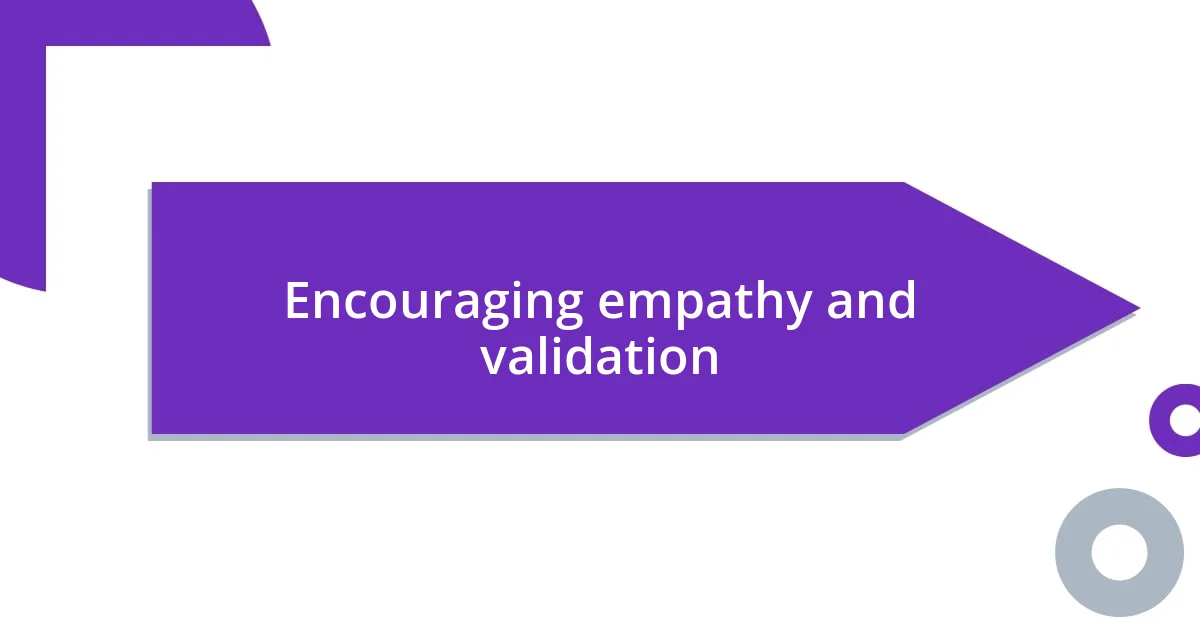
Encouraging empathy and validation
Empathy and validation are fundamental in any meaningful conversation. I’ve learned that when I genuinely listen to someone, acknowledging their feelings can go a long way. For example, during a difficult discussion with a friend who was going through a breakup, I made it a point to say, “It makes sense you feel that way; anyone in your shoes would.” This simple validation helped her feel seen and understood, allowing her to express herself more freely.
I often find that sharing my own experiences also fosters empathy. In a recent conversation with a colleague struggling with uncertainty in their career, I shared my own journey of feeling lost at one point. I remember saying, “I’ve been there, and it can be really challenging.” By connecting our experiences, it created a bridge between us, making them feel supported and less alone. Don’t you think sharing personal stories can break down barriers and deepen our connections?
Furthermore, body language plays a crucial role in conveying empathy. I remember a time when a friend was sharing a tough experience, and instead of just nodding along, I leaned in slightly and mirrored their expressions. This physical engagement not only reinforced my emotional support but also encouraged them to continue sharing. It’s fascinating to see how our non-verbal cues can enhance the sense of validation and allow others to feel safe in their vulnerability.
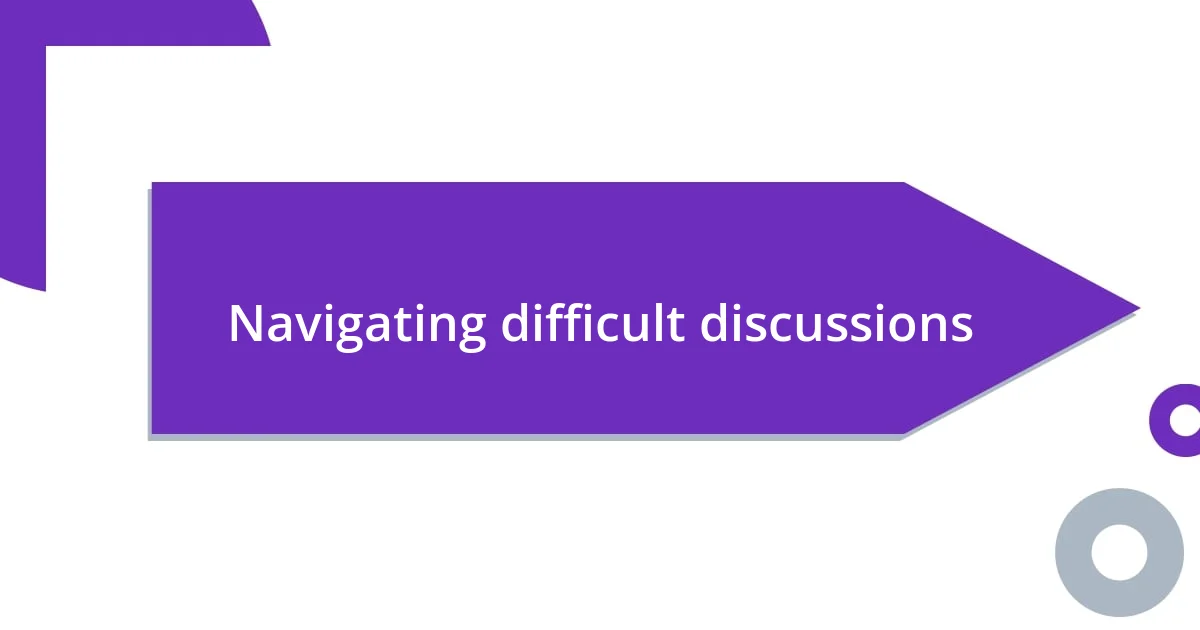
Navigating difficult discussions
Navigating difficult discussions can feel daunting, but I’ve learned that the right approach can open doors to deeper understanding. I recall a heated conversation with a family member over a sensitive topic. Instead of avoiding the discomfort, I chose to express my own apprehensions first, saying, “I can see why this is hard for both of us.” This admission not only softened the atmosphere but also invited them to share their perspective without feeling attacked.
What’s even more fascinating is how tone and pacing can influence the flow of a tough discussion. During a recent chat about differing political views, I consciously slowed my speech and maintained a calm demeanor. It was interesting to realize how my composure created a more relaxed environment, allowing us to explore our differences instead of spiraling into an argument. Have you ever noticed how our emotions can shape the outcome of a conversation?
Finally, it’s essential to remember that not every discussion will reach a resolution, and that’s perfectly okay. I had a candid conversation with a friend about our diverging life paths and felt a sense of tension rising. Instead of pushing for agreement, I suggested, “Let’s agree to disagree for now.” This acceptance allowed us to leave the conversation with respect for one another’s viewpoints, reinforcing our friendship despite our differences. Isn’t it refreshing to recognize that sometimes, just having the conversation is enough?
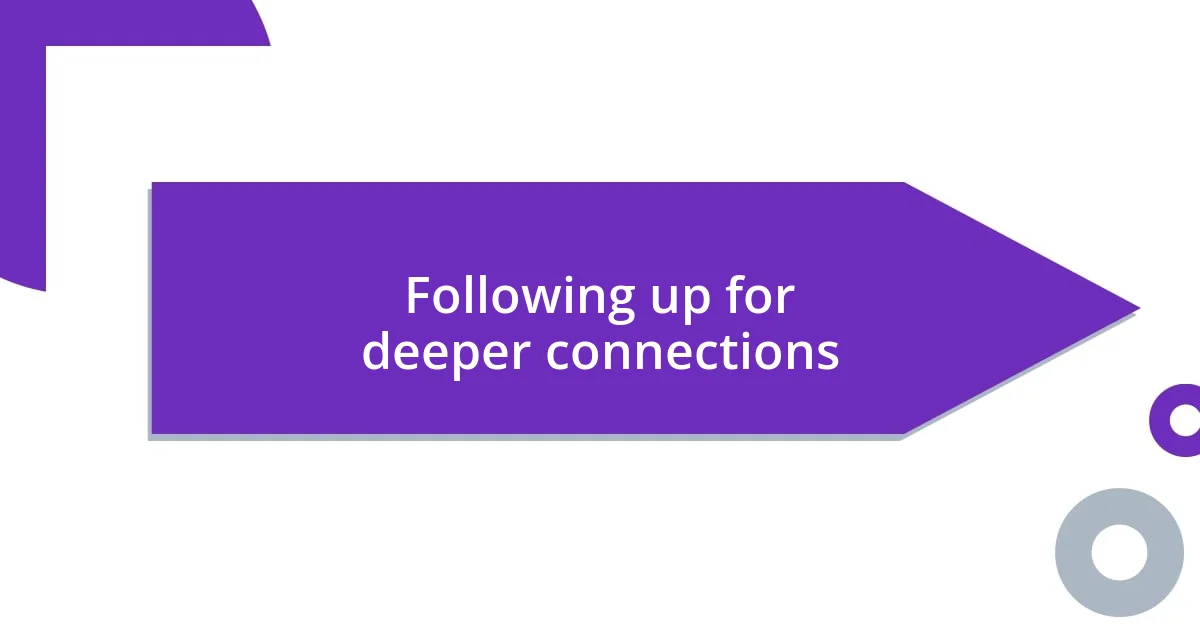
Following up for deeper connections
I can’t stress enough the importance of following up after meaningful conversations. A few months ago, I had a heart-to-heart with a friend about their struggles with anxiety. Afterward, I shot them a quick text saying, “Hey, I’ve been thinking about our chat. How have you been feeling since then?” That simple gesture conveyed that I truly cared and opened up a channel for them to share more. It’s remarkable how a follow-up can strengthen the bond, don’t you think?
Sometimes, following up can lead to unexpected revelations. I remember a colleague and I discussed our aspirations, and a week later, I reached out to see how they were progressing. They ended up sharing their fears about taking the next step, which allowed us to brainstorm solutions together. Those follow-up moments often morph into deeper dialogues, helping both parties reflect and grow in ways we couldn’t anticipate initially.
Additionally, don’t underestimate the power of consistency in follow-ups. I’ve made it a habit to check in with my close friends regularly, creating a supportive network where we all feel empowered to express our thoughts openly. Just last week, I noticed my friend had been quieter than usual, and I reached out, stating, “I’m here if you need to talk.” This consistency reinforces trust and keeps our connections alive, allowing for authentic conversations to flourish. Have you considered how often you check in with those who matter most to you?
